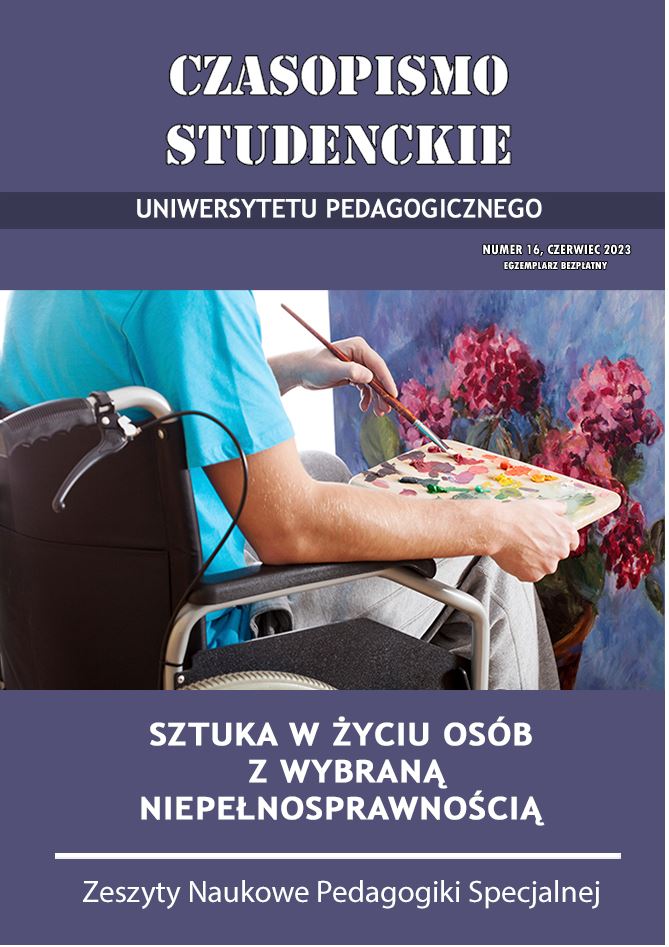Abstract
This article is about use a music therapy in working with blind people. The goals of music therapy are considered to be to promote emotional expression, develop a sense of identity, and improve social skills and quality of life. Music therapy for blind people is a relatively new field that involves the use of music and its properties in the process of improving and rehabilitating people with visual impairment. This article contains information on what techniques are used in music therapy, what are the goals, tasks, functions and principles of typhlomusictherapy. Music therapy should be carried out according to the following principles: stimulation of cognitive activity, strengthening of pedagogical leadership, shaping sensory experiences, development of tactile activities, intellectualization of music therapy interactions, development of interdependent activity at the earliest possible stages of development, shaping emotions and the ability to express them. It is recommended that music therapy in a facility for people with visual impairment be conducted on five levels, and these are: group classes, individual classes, cooperation with the family or care home, cooperation with the staff of the facility and education of the social environment. When working with visually impaired children with multiple disabilities, the greatest effects are achieved in teams of two to four people, with the help of a co-therapist. An individual music therapy meeting should last from 10 to 30 minutes, and a group one from 20 to 45 minutes. The effectiveness of music therapy depends on the frequency and regularity of these activities. According to the recommendations, they should take place throughout the school year, eg twice a week, each time at the same time of day, preferably in the morning. When creating a program of music therapy classes, didactic and revalidation guidelines for the blind and visually impaired should be taken into account and its content and methods of implementation should be constantly adapted to the abilities and difficulties of children. As part of typhlomusic therapy, we can use a very wide range of activities. These include: singing songs, making music using onomatopoeic objects (everyday use items), making music using instruments, listening to music, music and movement games, dancing, exercises to develop a sense of rhythm, vocal, instrumental and music and movement improvisations, psychodrama, pantomime, verbal and artistic interpretations of a selected piece of music, relaxation with the use of music, as well as therapeutic discussions aimed at presenting one's own preferences and musical impressions. It is very important to use the techniques alternately, because it allows you to achieve better therapeutic effects, and also makes the rehabilitation process more attractive.
References
Cylulko P., (1998), Muzykoterapia w rehabilitacji ruchowej dzieci niewidomych i słabo widzących, Upowszechnianie Nauki - Oświata "UN-O", Warszawa.
Cylulko P., (2004), Tyflomuzykoterapia dzieci: teoria i praktyka muzykoterapii dzieci z niepełnosprawnością wzrokową, Akademia Muzyczna we Wrocławiu, Wrocław.
Kaczmarek S., (2015), Kształtowanie zdrowia psychicznego młodzieży za pomocą improwizacji grupowych i indywidualnych w muzykoterapii. Zastosowanie muzykoterapii w psychosomatyce młodzieży., Polskie pismo muzykoterapeutyczne, nr 2, s. 1-76.
Kilian M. ., Cichocka M., (2011), Muzykoterapia w rehabilitacji dzieci niewidomych i słabo widzących – założenia teoretyczne (część 1), Szkoła Specjalna, wrzesień-październik, (4), s.245-257.
Kruczyńska A., Kurkowski Z., (2013), Muzyka i jej oddziaływanie na organizm człowieka, Nowa Audiofonologia, 2(3), s. 24–29.
Natanson T., (1992). Programowanie muzyki terapeutycznej, Akademia Muzyczna im. K. Lipińskiego we Wrocławiu, Wrocław.
Patterson A., (2003), Music Teachers and Music Therapists: Helping Children Together, Music Educators Journal, 89(4):35-38.
Szulc W., (2005), Muzykoterapia jako przedmiot badań i edukacji, UMCS, Lublin.
Wigram T., Nygaard Pedersen I., L.O.,(2002), A comprehensive guide to music therapy: theory, clinical practice, research and training, Jessica Kingsley Publishers, Londyn.

This work is licensed under a Creative Commons Attribution-ShareAlike 4.0 International License.

